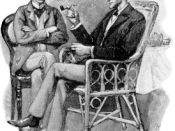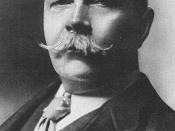In the late 19th and early 20th centuries the classical detective story thrived. Also during these centuries the middle class rose to social prominence. There are many classes of people in our world. While the upper class receives all the luxuries and the lower class receives all the attention, the middle class holds the majority of the people and had the biggest voice in society. Society rises and falls with the middle class. In Sir Arthur Conan Doyle's book "The Sign of Four" the status of the middle class continually comes into the readers mind. Sherlock Holmes, as the main character, tries to solve a mystery involving many people from the lower to middle class. In "The Sign of Four" Holmes and his trustworthy Dr. Watson undertake a case to help a young woman.
Ms. Morstan is a troubled woman that comes to Holmes for help. Her father has disappeared and she has no idea what happened to him.
She has one lead, and that is a contact, who every year send her a pearl. She is for the most part a middle class citizen except for the fact that unknown to her she is the heir to a treasure that could make her one of the richest ladies in the country. Not only is she the heir to a treasure, but she is a beautiful lady that catches the eye of Dr. Watson.
Dr. Watson is himself a middle class citizen. He lives with Holmes as friend and physician. Slowly Watson develops an attraction to Ms. Morstan, he cannot stop thinking about her, however with the knowledge that she is to become one of societies elites he decides to keep his feeling to himself. As we read further into the story we find that Ms. Morstan's treasure has...


